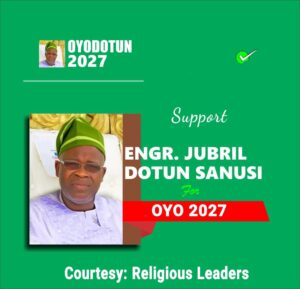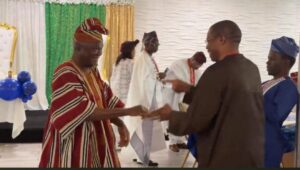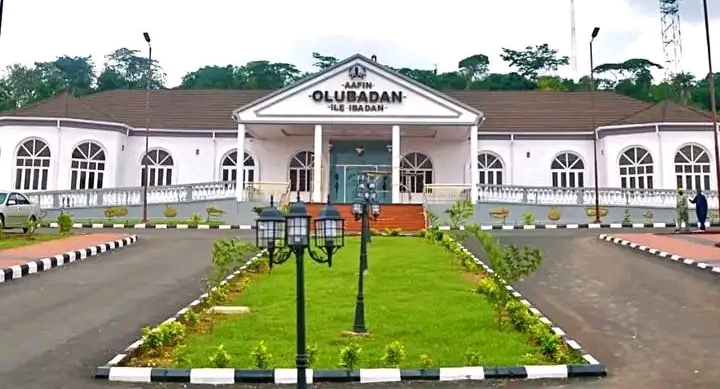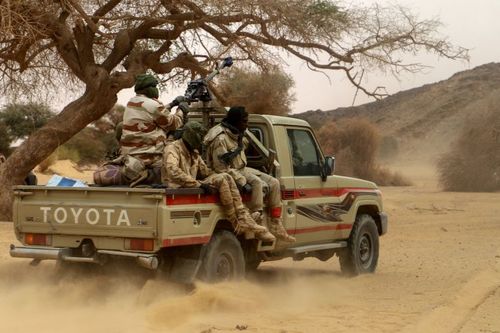Ogbomoso truly city of valiant – Oyo commissioner, reminisces about conspiracy against Akintola, Ogbomoso of 60s, Makinde’s ‘giant strides’
Femi OGUNLANA
Advertisement

Oyo state commissioner for information and orientation, Prince Dotun Oyelade, has justified the claim that Ogbomoso, second largest city in Oyo state, is “the land of valour,” noting its glistering military historical background, which he said is carried into the contemporary time, gives verve to this.
Prince Oyelade of Oolo compound, Ogbomoso, made this submission recently as part of his keynote address at the convention of the Ogbomoso Sons and Daughters North America (OSDNA) in Atlanta, USA.
The politician pointed out that the town gave protection to several distressed communities in the past and produced three Aare Ona Kakanfo (generalissimo of Yoruba Army), a heritage he noted is carried into the present time by producing sterling military and police top brass who served the nation exemplarily.
Among a host of others he mentioned Brigadier Benjamin Adekunle a.k.a. Black Scorpion, Col. Adegboyega Adeniran (both heroes of Nigerian Civil War), IGP Sunday Adewusi (a former Inspector General of Police), Col. Shittu Alao (former Chief of Air Staff), Major General Oladayo Popoola (a former military governor of Oyo and Ogun states) as modern day Nigerian heroes who helped to maintain the tradition.
Advertisement
“Because of our bravery and valour as you have known, many communities came to Ogbomoso for protection in the 19th century. I can report that to this day those traits are still embedded in our gender.
“Not less than three of the past 15 Are Ona Kakanfo are from Ogbomoso. We had Toyeje, then Ojo Aburumoku, Toyeje’s son and Samuel Ladoke Akintola, the 14th Are Ona kakanfo of Yoruba land. As a reminder, the Kakanfo is the Chief Warlord of Yorubaland.
“The first Chief of Air Staff during the Nigerian civil war of 1967-70 was from your town, Col. Shittu Alao. His plane came down during the period. Not in any particular order, you also have the following; Air Commodore Layi Atanda, who fresh from his advanced course in Germany was thrown into warfare and he excelled brilliantly with medals. Air Vice Marshal Jacob Adigun, Air Vice Marshal Lasisi Alao (the son of Col. Shittu Alao), Air Commodore Sola Oluokun [his blood brother, Jiboye is here], Air Commodore Ajani Aileru, Air Commodore Gabriel Oyekale, Air Commodore Iyiola Alao (one of the best pilots NAF ever produced who is still being engaged years after retirement). And many more.
“Throughout the world the pint-sized General Benjamin Adekunle, (the black scorpion) became known as the terror during the Nigerian civil war and he was to the Nigerian military what General Westmoreland was to America during the Vietnam war.
“He commanded the dreaded 3rd Marine Commando on many military exploits including the historic sea-borne assault on Bonny in the dangerous creek of south\south region.
“Colonel Adegboyega Adeniran was as brave as his kinsman and first fought as a combatant during the United Nation’s Peace keeping mission in the Republic of Congo in the early 60s before the Nigerian civil war broke out in 1967 where he equally served as a Sector commander.”
Advertisement
Reminiscing about the Ogbomoso of the fifties, sixties and the seventies during his own childhood and youth he hinted it was an exciting period though with limited facilities as he mentioned some leading luminaries and their contributions to the evolution of the town.
The veteran media practitioner also dwelled on the sterling achievements and contributions of late Ogbomoso icon who became second premier of the defunct Western Region, Chief Samuel Ladoke Akintola, however bemoaning how his accomplishments were subsumed under those of Chief Obafemi Awolowo, who was his boss and predecessor as premier.
“And you begin to wonder why the most popular Yoruba leader, Chief Jeremiah Obafemi Awolowo’s achievements are so amplified and while that of Samuel Ladoke Akintola should be a footnote,” he said.
Furthermore, the former chairman of Broadcasting Corporation of Oyo State (BCOS) highlighted some of the developmental strides of Governor Seyi Makinde, remarking they are geared towards improving the investing portfolio of the state through investment in the agricultural sector, road infrastructure, improved security and so on.
“The Seyi Makinde administration is investing a lot in the Agricultural sector and one of its areas of concentration is in the provision of road Infrastructure to link all the economic zones in the state.”
Advertisement
The convention attended by many sons and daughters of Ogbomoso in North America (USA, Mexico, Canada and others) was also addressed by the Soun of Ogbomoso Oba Ghandi Afolabi Olaoye and the Aale of Okelerin Oba Samuel Babatunde Amao.
Read full test of Prince Dotun Oyelade below:
BEING A KEYNOTE ADDRESS DELIVERED BY THE COMMISSIONER FOR INFORMATION AND ORIENTATION, OYO STATE, NIGERIA, PRINCE DOTUN OYELADE, ON THE OCCASION OF THE OGBOMOSO SONS AND DAUGHTERS NORTH AMERICA CONVENTION 2024, HELD AT ATLANTA BANQUET HALL, 560 THORNTON ROAD, SUITE 108 – 111 LITHIA SPRINGS, GA 30122 ON SATURDAY 27TH OF JULY, 2024.
MUSINGS FROM HOMELAND
For anyone who grew up in Ogbomoso in the fourties and the fifties as I did and rascally enough to have the effrontery passing through the dog-infested gardens of the white men living in the serene residential quarters of the Ogbomoso Baptist Hospital as it then was or the Theological Seminary, then you must know either Dr. George Green or Dr. J.C. Pool or both of them.
Dr. Green was a medical doctor who served the community for 37 meritorious years and would often treat patients from his home without grumbling. He died in 1962 virtually with the stethoscope glued to his ears. No wonder the Soun gave him the title Baasegun of Ogbomosoland.
While Dr. Pool was the Principal of the famous Ogbomoso Theological Seminary, the pastoral Institution with the Iconic architecture situated majestically between katika and Abepe.
He was the one with the strategic duty of brushing up converts and teaching them the doctrine of Christianity and turning them into effective Pastors and Evangelists.
As youths coming back from school or at weekends we would sneak in and help ourselves to the products of their rich gardens; Apples (pink and white), mangoes, assorted oranges and guava.
I can still remember the names of some of the notorious boys who invaded the comfort zones of the white Baptists. Kunle Ogunniyi, Bolanle Fawumi, Lekan Olaosebikan I think he resides in the US here, Debo Oluokun, Dele Adesina, Buraimoh Oladokun and a host of other irascible boys including one Dotun Oyelade.
Well, we were not always lucky but we were treated with kid gloves.
A few lashes of the cane were all we got from avuncular security men who have been strictly warned not to unleash the wild dogs on us.
At that time, Ogbomoso virtually started at Takie, Osupa, Bosunla, Agoodo, Ogede, Sekoni, Katika, Jagun, Aaje, Okelerin, Ojaigbo and probably ended at Masifa.
As for primary schools as far as my memory could go we had Ijeru Baptist Day School, DC school at Agboin, Areago DC school and Osupa Baptist Day school which had the bragging right of eminent graduates including Chief Samuel Ladoke Akintola the former Premier of Western Nigeria.
Indeed, Osupa Baptist Day school was to our community what Yale or Harvard is to America.
Apart from Mama Comfort Oladayo Oyadiran who served us the best Asaro in the world, Pa Amos Agboola Ajani, our Headmaster, was the best child manager. He would use his cane on us but you could read from his eyes that he was doing it out of duty not passion.
In the Ogbomoso of the 50s and the 60s everybody knew everybody. The few bad guys stuck out like sore thumbs and our parents thought us the virtue of decency and hardwork. “Ranti Omo Eniti Iwoose,” was a sobering refrain in our Ogbomoso community.
There is a guy among you here who resonated very well with my ambition to be a top journalist because he was determined to succeed in life too. His name is Ezekiel Adetunji who unsurprisingly is a successful medical doctor here in the US.
Three months before we wrote our final secondary school examination over 50 years ago, Ezekiel and I created a code of greeting ourselves each time we met. He would point a finger at me and say loudly June 20! And I will respond in like manner. June 20 was the final exam day and we couldn’t wait to shed our uniforms and go conquer the world.
At that time, there was only one library at Takie just behind the Post Office and the library was a small bungalow without fence overlooking a mechanic workshop. There was also only one Librarian, Mr Wole Adeosun, or Baba Segun, a native of Edunabon now in Osun state.
Everybody knew everybody in the Ogbomoso of our time and it was at this small modest Library that some of us began our dreams and saw the tool to break the shackles and barriers of our Spartan upbringing.
Spartan indeed because up till the 60s and the 70s we remained largely an agrarian community as the Odo Oba Dam which attracted a lot of workers was left in the lurch as a result of the assassination of the Premier in 1966.
Equally the western region Textile industry which was established by government to capitalise on our booming Aso Ofi trade was relocated to Iyin Ekiti, the home town of the military governor in 1967.
Thus Ogbomoso was left to its own design to develop its community and we reverted to farming and commerce which by providence got a big boost two years later when Dr. Kofi Busia repatriated our people from Ghana.

There was an iconic small building at Sabo that graphitized both the resilience and sense of humour of our people that came from Ghana. The sign board in front of the building simply read Oloungbo won lemin Ghana. This says something about the equanimity yet reality of the immigrants from the Gold Coast with their present circumstance.
By the time the Ghana people came in 1969, they did not meet on the ground, people who folded their arms; rather, they met a proud pool of instinctive traders who were adept in the true sense of katakara. So the combination of the emigrants and those they met at home was made in heaven.
There was Pa P.O. Ogunniyi who owned a large swath of buildings in the ancient town. His main businesses were a nursing home and booming wholesale cigarette business.
Pa Ogunniyi would ride to his Tikatore workplace each day in his Raleigh bicycle even though he parked a glittering American Chevrolet in his garage.
His vehicle dominated the narrow streets until weekends when the big boys came to town in their retinue of luxurious cars including a car called Humber and Chevy.
They were mainly politicians from Ibadan.
Pa Olawuyi Bamgbose was the first Surveyor General of the Western Region. He’s from ile Fapote. A renowned and highly successful quantity surveyor in his private capacity. He would visit at weekends to look up his aged mother in his glittering blue Mercedes Benz. He was so well connected to powerful men in high places including the Dodan Barracks where his sister was confidential secretary to the Commander-in-Chief, General Yakubu Gowon during the war. When his Mum finally died in 1968, Ogbomoso was literally shut down.
Military Big wigs, Federal and State commissioners, were there to dance to the tune of Tunde Martins alias Tunde Nightingale, ‘the bird that sings at night.’
In the Ogbomoso of that period there were less than a dozen private cars. There was Baba Ayo Alade who was another Tycoon whose house and thriving medical business were tucked at Sekoni. He also dealt in land sales. I recall that not a few of the elites would send their children abroad for further studies either in the UK or the USA. I can mention more than twenty by heart. Tokunbo Akintola, the last born of the late Premier was my mate at Osupa Baptist day school until 1960 when his parents took him to Eton, the Aristocratic school in England.
There was Pa Idowu Alagbon, who was the Czar of Peterson and Zochonis, PZ. He came in before the 1969 purge from Ghana to dominate commerce in his fatherland. Pa Aibinuomo was managing the UAC, near the Okelerin First Baptist Church. There was Pa Agbeluyi who was running GB Olivant. There was Pa Mafoluku who was a giant in the construction industry. It is instructive to note that Pa Agbeluyi, Pa Mafoluku and a few others were not indigenes, but they festered in their businesses without encumbrance.
There was the rotund popular trader, Mama Foyanmu, at Ogede whose big and well-stocked shop was so full that it spilled to the street opposite ile Olugbon. One kilometre away opposite PZ was Mama Babalola whose textile shop was equally dominant. And there were artisans, popular mechanics like Baba Idowu at Katika and Baba Mike at Apake and the irrepressible bicycle repairer by the Takie Baptist bookshop.
Oniworobos were many and managed their own spaces in their own right. So when our people came from Ghana, it didn’t take them too long to settle in because we were speaking the same business language. They did not come to dominate, No, rather they came to give verve to a commercial system that was already there.
Our nomadic nature is legendary and it is often said that when you get to a community and you do not find the trace of an Ogbomoso man there, pack your load and leave.
We possess some of the foremost educationists in Nigeria and the list can form half of a book if you care. To mention just a few of the Icons of education will suffice for the purpose of this project. Readily coming to mind are: Pa J.B.P Lafinhan, Pa G.O Otunla, Pa Ayo Adelowo, Pa E.A Iyanda, Pa E.G.O Gesinde, Pa Nathaniel Adibi, Mama Lydia Akande (the maverick French teacher from Ile Isude, who rode motorbike to school each morning), Mama Grace Ayodele Adeyemo, Pa B.A Oke, Pa J.B Ojo, and many more, all coming decades behind Prof. N.O Oyerinde who wrote THE HISTORY OF OGBOMOSOLAND.
UNEQUALLED HERITAGE
When it comes to tradition and culture, none is richer than the Ogbomoso model. Our Egungun festival was the cynosure of all eyes. Thank God Oba Afolabi Ghandi, the Soun of Ogbomoso is trying to reshape, glamourize and situate our cultural heritage in global perspective. In the 60s, Oyinbos would come from different parts of the world to witness the festival and wallow in the famous myth of our leading deities.
There was Dana Fojura, who feared no fire nor furnace; he felt cold in the midst of blistering fire and Ajomogbodo, who feared no law of gravity; he would sit comfortably in the air. There was Kongba, the irascible strong-head, there was Awodagbese, there was Oroko, there was Olukotun and Olojede the great dancer. His body was as malleable and flexible like clay in the hands of a gifted sculptor. Olojede existed well before the white men started their Ballet and choreographs
Then next in line were masquerades belonging to political tendencies like those owned by Broda Gbada, Broda Kinyo and Broda Samson.
Then you have the Kundukes. These were young energetic masquerades who engaged in physical combats through koboko. They would move about all over town terrorising the populace and later converge on Aaje\Okelerin for a festival of canes.
There was this place near ile Bunleyi at Fedegbo where we used to change to Ara orun kinkinkin. As I came out of the Iyewu and saw my teacher, Mr Adesoye, I burst into a run forgetting that he couldn’t have recognised me anyway.
No other Yoruba community that I know prides itself at advertising rich cultural names to identify their ancestral homes.
In Ogbomoso we do it with relish.
Ile Kulodi, ile Oolo, Ile Osalagbede, Ile Toosa, Ile Lawore, Ile Akogun, Ile Sina, Ile Alaasa, Ile Olakunsoro, Ile Gbamolabebe, Ile Jokodolu, Ile Sokoto, Ile Agbokan, Ile Akala, Ile Abo, Ile Osiagoro, Ile Otun, Ile Onigba, ile Areago, ile Olugbon, Ile Akinyo, ile Otukoko, ile Olukoko, ile Olokuta, ile Akinsi, Ile Aboosa, Ile Atoyote, Ile Alusekere, Ile Alasoro, ile Isalagbede, ile Akinbola, Ile Oloola Oke, ile Oloola Isale, ile Ajara, ile Baara, to mention just a few.
I apologise if your own ancestral home is not mentioned otherwise we won’t leave here for a long while.
The late Soun, Oba Jimoh Oyewumi Ajagungbade III, whose biography I authored in 1996 told me that in Ogbomosoland every community; every hamlet has a cultural name attached to it.
LAND OF VALOURS
Because of our bravery and valour as you have known, many communities came to Ogbomoso for protection in the 19th century. I can report that to this day those traits are still embedded in our gender.
Not less than three of the past 15 Are Ona Kakanfo are from Ogbomoso. We had Toyeje, then Ojo Aburumoku, Toyeje’s son and Samuel Ladoke Akintola, the 14th Are Ona kakanfo of Yoruba land. As a reminder, the Kakanfo is the Chief Warlord of Yorubaland.
The first Chief of Air Staff during the Nigerian civil war of 1967-70 was from your town, Col. Shittu Alao. His plane came down during the period. Not in any particular order, you also have the following; Air Commodore Layi Atanda, who fresh from his advanced course in Germany was thrown into warfare and he excelled brilliantly with medals. Air Vice Marshal Jacob Adigun, Air Vice Marshal Lasisi Alao (the son of Col. Shittu Alao), Air Commodore Sola Oluokun [his blood brother, Jiboye is here], Air Commodore Ajani Aileru, Air Commodore Gabriel Oyekale, Air Commodore Iyiola Alao (one of the best pilots NAF ever produced who is still being engaged years after retirement). And many more.
Throughout the world the pint-sized General Benjamin Adekunle, (the black scorpion) became known as the terror during the Nigerian civil war and he was to the Nigerian military what General Westmoreland was to America during the Vietnam war.
He commanded the dreaded 3rd Marine Commando on many military exploits including the historic sea-borne assault on Bonny in the dangerous creek of south\south region.
Colonel Adegboyega Adeniran was as brave as his kinsman and first fought as a combatant during the United Nation’s Peace keeping mission in the Republic of Congo in the early 60s before the Nigerian civil war broke out in 1967 where he equally served as a Sector commander.
There was Col Ibrahim Taiwo (military governor of Kwara state who was killed during the Dimka coup of 1976). There were Maj. Gen. Oladayo Popoola (a two-term military governor). Brig. Gen. Brimmoh Yussuf. Maj. Gen. Yussuf. Brig. Gen. Kofo Oke, Brig. Gen. E.A Olawoyin, Col. Daniel Akintonde (a former military governor), Col. J.A.P Oladipo, Brig. Gen. S.G Oladipo, Maj. Gen. Dapo Oyelade.
The head of the Nigerian Navy during the war and second in command to Gen. Yakubu Gowon was Rear Admiral Akinwale Wey. He was from your hometown. Ever since, Ogbomoso has maintained a highbrow presence in the Nigerian Navy. We’ve had: Rear Admiral Jacob Ajani, Rear Admiral David Adeniran, Rear Admiral Sunday Oyegade, Navy Commodore Sunday Olanrewaju Olawuyi (the biological senior brother to Gen. Popoola), Navy Commodore Gabriel Adebayo, Navy Commodore Oriola Onireti, and Commodore Abiodun Alade, to mention just a few.
In the Nigeria Police Force, Ogbomoso sons and daughters are exemplary. Here is a cursory list of the gallant officers: Inspector General of Police Sunday Adewusi, Assistant Inspector General Shehu Babalola, Deputy Inspector General (Mrs) Bisi Ugowe (The first female DIG in Nigeria),. Assistant Inspector General Olasupo Ajani, Commissioner of Police Oladejo Oyelowo, Commissioner of Police Samuel Adekunle, Commissioner of Police Ajala Ayoola, Commissioner of Police Moses Onireti, Commissioner of Police Samson Ogunlowo. So we have a fortified city.
It is not for nothing that we have the popular song, Adenu oko asinmi, adenu oko asinmi, ogun o jaja kokogbomoso, adenu oko asinmi.
It will be futile attempting to name and identify every prominent Ogbomoso sons and daughters who are worthy of being recognised in their own right as beacons of our community. They are in thousands including everyone here seated and around the world.
The Ogbomoso Community Foundation, OCF, under the pioneer leadership of former Inspector General of Police, Chief Sunday Adewusi, and later Major General Oladayo Popoola commissioned the publication of a compendium entitled BEACONS OF OGBOMOSOLAND in 2017.
We could only publish about 270 Entries before the deadline but Mr Bayo Oyegade, an accomplished Librarian and myself who authored the publication were exposed to the impressive list of qualified sons and daughters of Ogbomosoland strewn all over the world but who could not get their names and details published in the book.
Even the Ogbomoso of those era wasn’t all about farming, commerce, education and the military, they also had their fun! There was a family house at Abeepe called ile Onilu. They were always handy for all kinds of ceremonies and you don’t have to invite; they would simply emerge at the scene.
Then we had Baba Foyanmu. Baba Foyanmu keruobeko was so outstanding in his trade that many Patrons have spent and overspent beyond their capabilities when they got carried away by His Ijala rendition. There was Akanni Babarinde alias Bungalow and his local rival Denton Ade Romero. There was an older guy Gani Guitar, I cant remember his full name. They were all there for our people to enjoy themselves at weekends. And there was the multi-talented Odo Laye Aremu; though from Ilorin but he held his devoted Ogbomoso fans by the jugular .He waxed an emotive never-to-be-forgotten dirge for SL Akintola and he was a darling of many.
AKINTOLA’S ACHIEVEMENTS ARE BURIED WITH HIM
A few books have been written about him yet it will be an omission if I fail on this important occasion to dwell briefly on Chief Samuel Ladoke Akintola’s almost forgotten achievements.
As a result of the deliberate strategy of the media and their collaborators, the history and achievements of Chief Samuel Ladoke Akintola, the former and last Premier of western region cannot stand on its own. His achievements had to be subsumed by the western region crisis and his disagreement with Chief Obafemi Awolowo, his leader and predecessor in office. This needn’t be so because the western region crisis apart, SLA recorded many outstanding achievements for the region as a federal parliamentarian, Minister and Premier between Dec. 1960 and Jan. 1966 when he died.
So many literature have been published about the western region crisis, and I do not desire to regurgitate all that have been written because all of them are in public custody. Rather, I wish to interrogate what Akintola meant to history through his verifiable achievements and vision while in government, and indeed what lessons can be gleaned by the contemporary and coming generations.
To be sure, Akintola and Awolowo were political Siamese twins and their combination was made in heaven. One was exactly what the other was not. Indeed, Awolowo conceded political grand-standing to SLA, because, while SLA was given with the gift of the garb, Awolowo was taciturn and a little bit distant.
In 1960, when both of them landed at Ogbomoso, together in a helicopter, the first thing I observed, as an eight-year old inquisitive boy was their sartorial elegance. While Akintola disembarked from the chopper in wooly Kembe, Danshiki and Agbada, Awolowo followed him in a transperent white lace flowing agbada, over a chocolate velvet Buba. I took notice of the brown balley shoes both of them were wearing and their leather wrist watches.
Akintola would whip-up raw emotion, with his alliterative and sarcastic remarks that combine verbal imagery and mimicry and while Awolowo’s follow-up remarks were not an outright anti-climax, he would succeed in sombring up the mob with convincing data and science, the way a strict headmaster would conduct himself.
A politician was once quoted as saying that, ‘if you don’t want to be convinced or swayed to the other side, do not allow SLA to speak to you.’
Since the beginning of politics in Nigeria, to date, there has never been a more successful political combination, like the two gladiators.
To my mind, Akintola’s major offence at the time was being a pragmatic politician. He did not deceive himself that Chief Obafemi Awolowo’s success as a regional administrator could translate into realising his ambition as the Prime Minister of Nigeria.
He was quoted as advising his boss, Awolowo, that his political clout would not match his ambition unless there was handshake across the Niger. Not once did Akintola query the leadership of his boss and was ready to deploy his deep understanding of the Hausa language and northern affiliation to fester the ambition of his boss. But as it turned out, when he had his back to the wall, he deployed the same asset to protect himself. Akintola was a nationalist to the core, experienced and versed in the tenuous craft of give-and-take.
As the editor of a national daily, The Daily Service, he had bitter engagement with his colleague, Dr Nnamdi Azikwe, editor of the West African Pilot, among others and both sheath their swords the moment they left journalism for politics.
Akintola might have had the opportunity to march Chief Awolowo’s own achievement between 1952 and 1960 but for the internal crisis that bugged him down. He was well prepared for the job of premiership.
He was the first Minister of Labour for the federation, a portfolio he chose for himself because of his interest in labour matters. He later moved to be Minister of Health and later still, Communication and Aviation.
His loyalty to his boss and party throughout this period was never in doubt and when in April 1953 it became incumbent for all AG Ministers to vacate their positions at the federal level, he did not blink an eye and resumed his position immediately as the leader of Opposition in the federal parliament.
And you begin to wonder why the most popular Yoruba leader, Chief Jeremiah Obafemi Awolowo’s achievements are so amplified and while that of Samuel Ladoke Akintola should be a footnote.
It is on record that as the federal minister of health, SLA played a pivotal role in the establishment of the University Teaching Hospital Complex, Ibadan. In his capacity as the minister of health, he was able to release the sum of ten million pounds to aid the completion of UCH. As a result of that lifeline, UCH was relocated from Adeoyo Hospital to its permanent site in 1956. And in 1957, when he was reappointed to the federal cabinet and was Minister of Communication and Aviation, he realised one of his dreams by breaking the monopoly of British Airlines with the establishment of the Nigerian Airways. He it was that the federal government sent to Holland to source for new airplanes for the newly established Nigerian Airways.
Till this day, it is still a mystery that the establishment of the University of Ife in 1961 was never credited to Chief Samuel Ladoke Akintola who at the time was not only the Premier of western region, Visitor to the university and one of those at the frontline of establishing the University while he was deputy Premier.
Equally baffling is the refusal to credit SLA with the establishment of the Daily Sketch newspaper which was founded by the regional government on December 2, 1964 under his watch as Premier.
These oversights and many more are reasons why we should believe those who say that Perception is often stronger than real governance.
And as the Yoruba adage says “Kosigba tadaso tarile fiwo.” It is so soothing and a relief that our people together with well-wishers fought successfully to name the State university after Ladoke Akintola.
That institution, now fully owned by Oyo state, thanks to the efforts of the State governor Seyi Makinde, remains the best State university in Nigeria as I speak.
LAUTECH enrols over 30,000 students and almost 4,000 staff.
The institution has radically turned around the economy of Ogbomosoland and commercial transactions run into hundreds of millions of naira every month. The Institution has equally expanded to Iseyin where the Agricuture Faculty is located.
Also heart-warming is the re-naming of the Ibadan airport to Ladoke Akintola International airport on June 1, 2023 thereby bringing a compensation whose foundation was laid in 1957 when SLA established the Nigerian Airways.
RIGHT TIME TO INVEST IN OYO STATE
It is pertinent at this juncture to discuss some of the projects which the current Administration in Oyo State is undertaking and which will be beneficial to those of you in the diaspora who may wish to invest and should invest back at home.
The Seyi Makinde administration is investing a lot in the Agricultural sector and one of its areas of concentration is in the provision of road Infrastructure to link all the economic zones in the state.
Lack of good roads to connect to agricultural areas had been the bane of taking full advantage of our God-endowed farmlands. In this regard the state government has strategic roads linking all Agribusiness zones in the sate. We have the 65km Ibadan/Iseyin road completed for the Ijaye Agribusiness Industrial Estate. We have the 38km Oyo, Fasola/Iseyin road for Fasola Industrial Estate. Also the Ogbomoso-Fapote-Iseyin road linking the LAUTECH School of Agriculture, Iseyin. We have the ongoing 48km Ido-Eruwa road and the Apete-Awotan-Akufo road targeting the Akufo Farmers market. The Ladoke Akintola International airport will serve also as a cargo airport for farmers produce. And Investors are guaranteed an improved Western Nigeria Security Network otherwise called Amotekun which has the largest number of personnel and facilities in the South West.
The Fasola industrial estate is completely fenced with drone surveillance, tarred roads, tennis court, housing facilities for investors, crèche for children and accessibility to raw materials through good roads in agrarian communities.






